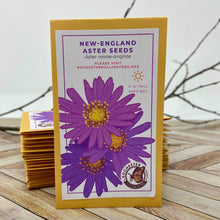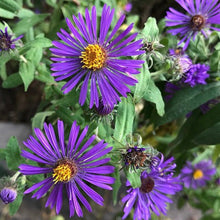New England Aster (Aster novae-angliae)
Perennial
Seed Count: approx. 150 seeds
Days to Germinate: 60 days of cold, moist stratification. See: Winter Sowing & Stratification
Depth to Sow: 1/4"
Seed Spacing: When seedlings are 2" high, thin to 1' apart
Color: purple
Height: up to 5'
Bloom Time: August - October
Sun Exposure: Full to partial sun
Soil Moisture: Wet to medium dry soil
Soil Type: Sand, loam & clay
Attracts: Monarch butterflies, birds, bumblebees, honeybees, other native bees
Natural Habitat: Open lands, thrive in grasslands, old fields, savannas, and woodlands. Found on roadsides, fencerows and at the edge of a forest
Drought Tolerance: Moderate
Deer Resistance: High
Larval Host: Pearl Crescent and Gorgone Checkerspot butterflies, and Wavy-lined Emerald moth
Native Zone: AL, AR, CO, CT, DC, DE, GA, IA, IL, IN, KS, KY, MA, MD, ME, MI, MO, MS, MT, NC, ND, NE, NH, NJ, NM, NY, OH, OK, OR, PA, RI, SC, SD, TN, UT, VA, VT, WA, WI, WV, WY
Pure Live Seed (PLS) Viability Value: 61.8%
Description:
New England Aster is a late bloomer like most Asters. Maturing to 5' tall, it is rich with purple flowers with orange-yellow centers from late summer to October. Popular with pollinators, it thrives in full sun or light shade in all but the driest soils. Before New England Aster blooms, it is easy to identify the plant because of the hairy stem and leaves that clasp the stem in a distinctive manner, nearly encircling it, unique from other Asters (see photo).
The colors of the New England Aster can vary from purple, violet, and lavender to all shades of pink. Bees and butterflies are attracted to it, and the nectar of the flower provides an excellent source for Monarchs and other butterflies late into the fall. New England Aster is drought-tolerant and deer-resistant. When the plant is blooming, the lower leaves can often dry up causing some to think the plant is dying or has disease. This is normal, so don't be alarmed.
Info from www.prairiemoon.com




